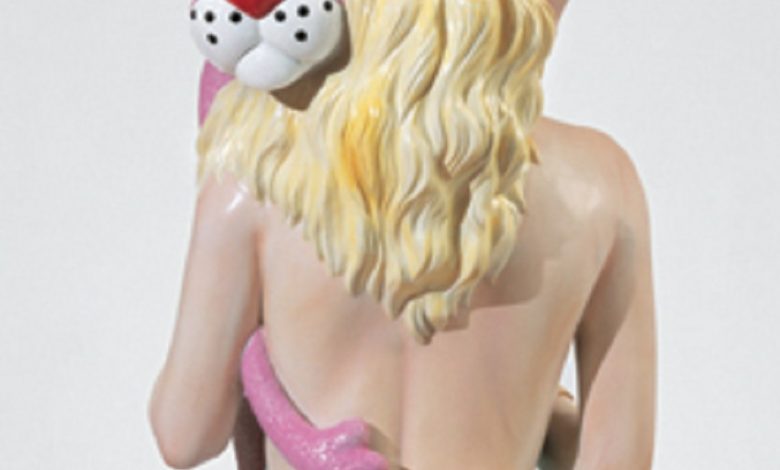
Jeff Koons is a modern artist who thrives on pushing boundaries and sparking conversation. His work is often provocative, referencing everything from pop culture icons to sexuality. He’s known for transforming everyday objects into high-end art, blurring the lines between “good” and “bad” taste. Love him or hate him, Koons is undeniably influential, and Jeff Koons Pink Panther sculpture is a perfect example of why.
Jeff Koons Pink Panther: A Porcelain Pop Culture Icon
At first glance, Jeff Koons Pink Panther might seem like pure kitsch. It’s a porcelain sculpture of a topless, smiling blonde woman clutching a cartoon Pink Panther. The woman is modeled after 1960s Hollywood starlet Jayne Mansfield, an actress known more for her physical attributes than her acting chops.
The sculpture is just over three feet tall, deliberately life-sized to make the viewer a part of its world. And what a world it is! With its bright colors, smooth glaze, and cartoonish characters, “Pink Panther” is a clash of pop culture, kitsch, and sexuality.
The Banality Series
“Pink Panther” was a part of Koons’ “Banality” series (1988), a collection of work that examined the concept of taste. Banality itself means something ordinary, even boring, so right away Koons sets us up to think about the objects we see every day. Was this sculpture just high-end kitsch – something anyone could buy in a less glamorous form at a souvenir shop – or was it worthy of deeper consideration?
Koons’ work is often ironic, using humor and familiar references to make us think. Is he poking fun at our love of consumer culture? Is he questioning what we value in art? Or is he celebrating the ordinary objects and images that fill our lives?
What’s With the Pink Panther?/
The cartoon Pink Panther was wildly popular when Koons was a child. It was a symbol of a certain playful sophistication. Koons, the master of pop culture references, chose the Pink Panther for its nostalgic charm and what it represents.
The Pink Panther character is a bit of a paradox: He’s suave and cool yet prone to clumsy mistakes. He’s sly but also innocent. This mirrors the woman’s expression: she’s both playful and seductive, holding her audience in her gaze but with a knowing smile that hints at a more profound irony.
Sexuality and Humor
Koons plays heavily with sexuality in his work, and “Pink Panther” is no exception. The woman is a blatant pin-up figure, a symbol of idealized femininity. Yet, there’s something exaggerated and artificial about her. This artificiality is both jarring and oddly humorous. The Pink Panther, dangling limply in her grasp, amplifies the humor slightly absurdly.
Humor is a way of disarming us, and Koons uses it to make us question our reactions. Do we feel uncomfortable looking at this overtly sexualized sculpture? Do we feel tempted to dismiss it as bad taste? The tension Koons creates between attraction and discomfort is deliberate.
Challenging the Art World
With “Pink Panther” and his other Banality works, Koons wasn’t just messing with our ideas of taste; he was challenging the art world. Porcelain sculptures of this type were traditionally associated with sentimental figurines, not serious high art. By creating huge, flawlessly executed porcelain works based on mass-produced kitsch, he questioned the art world’s gatekeepers. What makes a work of art legitimate?
Multiple Interpretations
One of the most exciting things about “Pink Panther” is its openness to interpretation. Some view it as an ironic critique of our culture’s obsession with beauty, fame, and material possessions. Others see it as a celebration of everyday objects and the joy they can bring. Still, others may view it more critically, finding it shallow or exploitative.
In a way, it doesn’t matter which interpretation resonates with you the most. The point Koons seems to be making is that art is meant to make us think and, sometimes, to make us uncomfortable. The fact that “Pink Panther” still sparks heated debate decades later is a sign of his success.
Ambiguity as a Tool
Ambiguity – that sense of multiple possible meanings – is one of the key elements that makes “Pink Panther” such a fascinating piece. Koons is a master of leaving things open. Is he sincerely celebrating the beauty of pop culture objects? Is there something more critical going on? He never really spells it out for us.
In a way, this strategy makes the viewer a part of the art. We are the ones who have to decide how we feel about “Pink Panther”. Do we admire its audacity? Do we find it funny, disturbing, or something else entirely? When art makes us question our reactions, maybe that’s part of its purpose.
The Role of Taste
Jeff Koons Pink Panther makes us confront our tastes and values. Many would consider this sculpture the definition of “kitsch.” It’s gaudy, deliberately sentimental, and plays on well-worn cultural symbols. But what is kitsch, exactly? Is it inherently “bad?” And what happens when something considered kitsch is presented on a grand scale and given the high-art treatment?
Koons seems to be inviting a discussion on all these issues. By making the banal monumental, he’s questioning the boundaries we place around art. Is it the size of the work that makes it art? The price it fetches at auction? Or the depth of ideas it expresses?
The Power of Nostalgia
“Pink Panther” plays strongly with nostalgia. For many people who grew up with the cartoon, the sculpture evokes childhood feelings and a sense of simpler, more playful times. Koons taps into this nostalgia with the cartoon figure but adds a touch of cynicism. Is our obsession with the past holding us back from exploring new and challenging ideas in art?
Nostalgia can be a powerful emotion. Think about the things that make you nostalgic – an old song, a childhood toy, a favorite movie. That sense of longing comes from what we’re remembering is gone. In that way, perhaps Koons wants us to consider the loss of something when it becomes an object of art.
Art and Commerce
Koons is no stranger to the commercial side of art. His work sells for astronomical sums and he’s collaborated with brands to mass-produce versions of his sculptures. Critics have accused him of focusing on money and fame rather than artistic integrity. But maybe that’s the point.
“Pink Panther” and the Banality series walk a fine line between celebrating and critiquing our mass consumer culture. Could it be that Koons is forcing us to confront the fact that art is a commodity – an object to be bought and sold? When art reaches a certain value, does the intention of the artist even matter anymore?
Last Words
The fact that we’re still talking about “Pink Panther” nearly 35 years after its creation speaks to the power of Koons’ work. He continues to be one of the world’s most controversial and divisive artists. Some dismiss him as a showman who creates art for shock value, while others see him as a genius who raises essential questions about art and culture.
Whether you love or hate him, Jeff Koons has undoubtedly impacted the art scene. With Jeff Koons Pink Panther, he invites us into a world of kitsch, humor, and ambiguity, asking us to reconsider our ideas about taste, beauty, and the role of art in our lives.
FAQs
Where can I see “Pink Panther” in person?
There are a few versions of the sculpture, and they belong to institutions like the Museum of Modern Art in New York and the Museum of Contemporary Art in Chicago.
How much is “Pink Panther” worth?
Because of its notoriety, “Pink Panther” would likely sell for millions of dollars if it went to auction.
Is Jeff Koons still active as an artist?
Very much so! Koons continuously pushes boundaries with his work, exploring new mediums and technologies.
What is Koons’ most famous work?
It’s a toss-up between “Balloon Dog” (his giant, metallic balloon animal sculptures) and perhaps “Rabbit,” a similarly styled piece.
Where can I learn more about Jeff Koons?
There are numerous books, documentaries, and even his website (https://jeffkoons.com/) to help you learn more and discover his diverse range of work.





